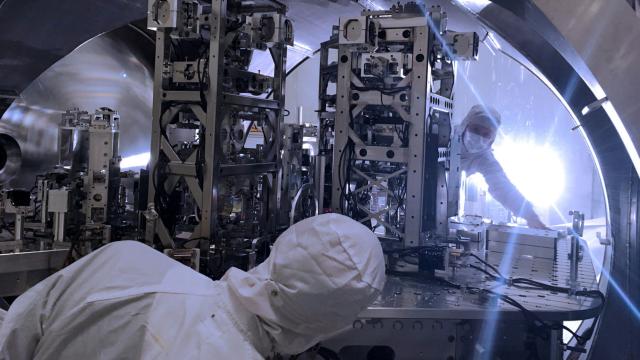A pair of objects, each more massive than the Sun but only as wide as a city, have once again produced ripples in spacetime that were picked up by sensitive gravitational wave detectors on Earth. But this time, scientists think they may have measured something even weirder the usual.
After booting up a month ago for their third observing run, the Virgo and two LIGO gravitational wave observatories have already measured five potential gravitational wave signals. These include three potential collisions between black holes, a pair of colliding neutron stars, and maybe even a neutron star colliding with a black hole. The LIGO and Virgo science collaborations are releasing their detections publicly in near-real time so that astronomers around the world can immediately follow up with their own observations.
“We expect there will be much more insight into the laws of nature and the universe in this observing run to come and beyond,” Jess McIver, senior postdoctoral scholar in experimental physics at the LIGO Laboratory at Caltech in Pasadena, said in a press conference.
After the Nobel Prize-winning 2015 observation of gravitational waves from colliding black holes, the LIGO and Virgo experiments now routinely measure these gravitational disturbances the way that other telescopes might measure gamma ray bursts. The ripples pass through the LIGO and Virgo observatories, which split laser beams, send them down mile-plus-long pipes, and rejoin the beams on a detector. A gravitational wave would cause one of the lasers’ paths to change, producing subatomic-sized interference patterns after the beams are united.
Black hole collisions have become nearly routine, but neutron star collisions have produced a host of interesting science results, since they also come with a corresponding electromagnetic signal. The resulting explosion, called a “kilonova,” provides the energy required to produce many of the elements heavier than iron, even in our own solar system.
These collisions also provide a way to measure how quickly the universe is expanding by comparing the wavelength of the resulting flash to the distance that the gravitational waves had to travel to arrive at the Earth. LIGO and Virgo Scientists measured evidence of a second neutron star collision on April 25.
But the detectors had never spotted a black hole colliding with a neutron star — until the next day, April 26. This detection could be helpful in multiple ways. It’s a first, so that’s interesting on its own. But it can also help scientists explain where in the universe such pairs form, as well as the orientation of the black hole as it spins compared to its binary partner. It would provide an even better way to measure the universe’s expansion, Salvatore Vitale, assistant professor at the LIGO Lab of MIT, said during the press conference.
There’s currently a discrepancy between the various ways that scientists measure how fast the universe is expanding, so any additional independent measurements help.
LIGO and Virgo announce detections mainly through GCN Circulars, which provide various pieces of evidence to astronomers around the world, including the approximate location of the source that produced the waves, the chance that the detectors spotted a false alarm, and what might have produced the signal.
“The follow-up community is really excited that things are happening again,” Edo Berger, professor of astronomy at Harvard University, told Gizmodo. He explained that one of his students was giving a Ph.D defence when the April 26 signal came in, setting off alerts on both of their phones.
But following up on all these signals has been and will continue to be challenging, Berger said. At present, he felt that there’s some potentially useful gravitational wave data missing from the GCN circulars, especially given how valuable telescope time can be. “The more information we have, the more clarity we’re going to have” about which events to follow up on. He explained that the April 26 event came with a relatively high chance that it was a false alarm.
Still, it’s a thrilling time for astrophysics—neutron star collisions might come in each month, and black hole collisions even more frequently, from much farther out in the universe. More data will tell us more about these powerful events than ever before. For now, the gravitational wave detectors are more sensitive than ever, and will receive further upgrades at the end of this observing run in spring 2020.
A Japanese detector, KAGRA, will join the group then, too. While there are some growing pains and the usual issues that come with any large effort, world-wide collaboration between different kinds of observatories is teaching scientists more about the universe than ever before.
